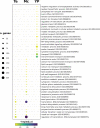Tomato POLLEN DEFICIENT 2 encodes a G-type lectin receptor kinase required for viable pollen grain formation
- PMID: 36260406
- PMCID: PMC9786849
- DOI: 10.1093/jxb/erac419
Tomato POLLEN DEFICIENT 2 encodes a G-type lectin receptor kinase required for viable pollen grain formation
Abstract
Pollen development is a crucial biological process indispensable for seed set in flowering plants and for successful crop breeding. However, little is known about the molecular mechanisms regulating pollen development in crop species. This study reports a novel male-sterile tomato mutant, pollen deficient 2 (pod2), characterized by the production of non-viable pollen grains and resulting in the development of small parthenocarpic fruits. A combined strategy of mapping-by-sequencing and RNA interference-mediated gene silencing was used to prove that the pod2 phenotype is caused by the loss of Solanum lycopersicum G-type lectin receptor kinase II.9 (SlG-LecRK-II.9) activity. In situ hybridization of floral buds showed that POD2/SlG-LecRK-II.9 is specifically expressed in tapetal cells and microspores at the late tetrad stage. Accordingly, abnormalities in meiosis and tapetum programmed cell death in pod2 occurred during microsporogenesis, resulting in the formation of four dysfunctional microspores leading to an aberrant microgametogenesis process. RNA-seq analyses supported the existence of alterations at the final stage of microsporogenesis, since we found tomato deregulated genes whose counterparts in Arabidopsis are essential for the normal progression of male meiosis and cytokinesis. Collectively, our results revealed the essential role of POD2/SlG-LecRK-II.9 in regulating tomato pollen development.
Keywords: Male sterility; RNA interference; mapping-by-sequencing; microgametogenesis; microsporogenesis; parthenocarpic fruits; pollen formation; receptor kinases; tapetum development; tomato.
© The Author(s) 2022. Published by Oxford University Press on behalf of the Society for Experimental Biology.
Figures







References
-
- Atanassova B. 2000. Functional male sterility in tomato (Lycopersicon esculentum Mill.) and its application in hybrid seed production. Acta Physiologiae Plantarum 22, 221–225.
-
- Brukhin V, Hernould M, Gonzalez N, Chevalier C, Mouras A.. 2003. Flower development schedule in tomato Lycopersicon esculentum cv. sweet cherry. Sexual Plant Reproduction 15, 311–320.
-
- Cai W, Zhang D.. 2018. The role of receptor-like kinases in regulating plant male reproduction. Plant Reproduction 31, 77–87. - PubMed
-
- Cao X, Liu X, Wang X, et al. . 2019. B-class MADS-box TM6 is a candidate gene for tomato male sterile-15. Theoretical and Applied Genetics 132, 2125–2135. - PubMed
Publication types
MeSH terms
Substances
LinkOut - more resources
Full Text Sources

